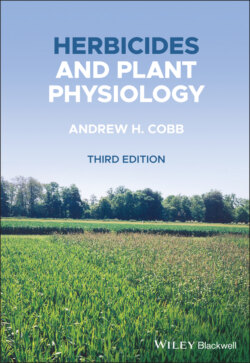Читать книгу Herbicides and Plant Physiology - Andrew H. Cobb - Страница 17
1.4.1 Yield losses
ОглавлениеCrop losses approaching 100% are recorded in the literature (Table 1.3; Lacey, 1985). Such yield losses will, of course have a profound effect on a national economy in terms of both the need to import foodstuffs and the costs of weed control. Despite the many methods of weed management that are now available worldwide, it is estimated that approximately 13% of crop losses are still due to weeds alone (Table 1.4). Indeed, in 1974 the annual cost of weeds to agriculture in the USA was estimated at US$10 billion, with 50% owing to yield reductions and 50% owing to the cost of weed control (Rodgers, 1978).
In the tropics, parasitic weed species from the genera Cuscuta (dodders), Orobranche (broomrapes) and Striga (witchweeds) can have a profound effect on a range of crops. They absorb nutrients directly from the crop plant, which may not set seed at all in the case of cereals such as sorghum.
Weed control techniques are therefore aimed at the reduction in the competitive ability of weeds in a crop and the prevention of weed problems in a future crop. The former is increasingly based on chemical use, and the latter also requires suitable cultural and agronomic practices.
Yield loss may be usefully related to the number of weeds per unit area causing a defined yield loss in a defined crop, that is, as a Weed Threshold (Table 1.5) or as a Crop Equivalent (the amount of resource an individual weed uses expressed as the number of crop plants this resource would support, although in practice it is the biomass of the weed and the crop which is measured). Generally, these figures have only been determined for weed interaction with major crops, but they give a good indication of the ability of a particular species to compete with all crops.
Table 1.3 Examples of yield losses owing to weeds.
Source: Lacey, A.J. (1985) Weed control. In: Haskell, P.T. (ed.) Pesticide Application: Principles and Practice. Oxford: Oxford University Press, pp. 456–485. Reproduced with permission of Oxford University Press.
| Crop | Yield loss (%) | Country |
|---|---|---|
| Cassava | 92 | Venezuela |
| Cotton | 90 | Sudan |
| Groundnuts | 60–90 | Sudan |
| Onions | 99 | UK |
| Rice | 30–73 | Colombia |
| Sorghum | 50–70 | Tanzania/Nigeria |
| Sugar beet | 78–93 | Texas, USA |
| Sweet potatoes | 78 | West Indies |
| Wheat* | 66 | UK |
| Yams | 72 | Nigeria |
* From Moss (1987).
Table 1.4 Estimated percentage crop losses owing to weeds, 1988–90 (from Oerke et al., 1995).
Source: Oerke, E.C., Dehne, H.W., Schonbeck, F. and Weber, A. (eds) (1995) Crop Production and Crop Protection: Estimated Losses in Major Food and Cash Crops. Amsterdam: Elsevier.
| Estimated loss owing to weeds (%) | |
|---|---|
| Africa | 16.5 |
| North America | 11.4 |
| Latin America | 13.4 |
| Asia | 14.2 |
| Europe | 8.3 |
| Former Soviet Union | 13.0 |
| Oceania | 9.6 |
| Average | 13.1 |
Table 1.5 Relative competitive abilities of a number of common weeds found in winter cereals.
Source: Lutman, P.J., Boatman, N.D, Brown V.K. and Marshall, E.J.P. (2003) Weeds: their impact and value in arable ecosystems. In: The Proceedings of the BCPC International Congress: Crop Science and Technology 2003 1, 219–226.
| Weed species | 5% yield loss (plants m−2) | Weed species | 5% yield loss (plants m−2) |
|---|---|---|---|
| Galium aparine | 1.7 | Poa annua | 50.0 |
| Anisantha sterilis | 5.0 | Epilobium spp. | 50.0 |
| Avena fatua | 5.0 | Polygonum aviculare | 50.0 |
| Lolium multiflorum | 8.3 | Sonchus spp. | 50.0 |
| Alopecurus myosuroides | 12.5 | Taraxacum officinale | 50.0 |
| Brassica napus | 12.5 | Fumaria officinalis | 62.5 |
| Sinapis arvensis | 12.5 | Geranium spp. | 62.5 |
| Tripleurospermum inodorum | 12.5 | Lamium purpureum | 62.5 |
| Cirsium spp. | 16.7 | Ranunculus spp. | 62.5 |
| Convolvulus arvensis | 16.7 | Veronica spp. | 62.5 |
| Fallopia convolvulus | 16.7 | Aethusa cynapium | 83.3 |
| Papaver spp. | 16.7 | Senecio vulgaris | 83.3 |
| Chenopodium album | 25.0 | Anagallis arvensis | 100.0 |
| Myosotis arvensis | 25.0 | Allium vineale | 250.0 |
| Persicaria maculosa | 25.0 | Aphanes arvensis | 250.0 |
| Silene vulgaris | 25.0 | Legousia hybrida | 250.0 |
| Stellaria media | 25.0 | Viola arvensis | 250.0 |
Yield loss may also occur in addition to direct competition for resources. Allelopathy is the production of allelopathic chemicals by one plant species that may inhibit (or, in the case of positive allelopathy, stimulate) the growth of other species. Anecdotal evidence of negative allelopathic effects has been reported for a number of weed species, although supporting research is often lacking. Recent findings have been reviewed by Olofdotter and Mallik (2001) and others (see Agronomy Journal vol. 93). Given the ample evidence of allelopathy exhibited by crop species, it is highly likely that many weed species will also display these effects, and that it is only a matter of time before research demonstrating this becomes readily available.
Further examples of yield loss caused by weeds include the effects on non‐plant organisms. One example of this is the presence of dandelion (Taraxacum officinale) in fruit orchards. Dandelion flowers are preferentially visited by insect pollinators and so pollination of fruit blossom (and therefore fruit yield) is reduced.
